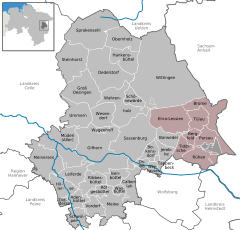Rühen
From Wikipedia, the free encyclopedia
| Rühen | ||
|---|---|---|
 | ||
| ||
 Rühen | ||
Location of Rühen within Gifhorn district 
 | ||
| Coordinates: 52°29′N 10°52′E / 52.483°N 10.867°ECoordinates: 52°29′N 10°52′E / 52.483°N 10.867°E | ||
| Country | Germany | |
| State | Lower Saxony | |
| District | Gifhorn | |
| Municipal assoc. | Brome | |
| Subdivisions | 3 | |
| Government | ||
| • Mayor | Waldemar Peters (CDU) | |
| Area | ||
| • Total | 30.89 km2 (11.93 sq mi) | |
| Elevation | 65 m (213 ft) | |
| Population (2012-12-31)[1] | ||
| • Total | 4,862 | |
| • Density | 160/km2 (410/sq mi) | |
| Time zone | CET/CEST (UTC+1/+2) | |
| Postal codes | 38471 | |
| Dialling codes | 05367 | |
| Vehicle registration | GF | |
Rühen is a municipality in the district of Gifhorn, in Lower Saxony, Germany.
History
Between 1945 and 1990 Rühen served as West German inner German border crossing for inland navigation on the Mittellandkanal. The crossing was open for freight vessels navigating between the Soviet Zone of occupation in Germany (till 1949, thereafter the East German Democratic Republic), or West Berlin and the British zone of occupation (till 1949) and thereafter the West German Federal Republic of Germany. The traffic was subject to the Interzonal traffic regulations, that between West Germany and West Berlin followed the special regulations of the Transit Agreement (1972).
References
This article is issued from Wikipedia. The text is available under the Creative Commons Attribution/Share Alike; additional terms may apply for the media files.
